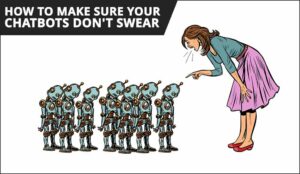Nikolett Török at Cyara explains how to avoid chatbot fails.
Businesses of all kinds are increasingly realizing the value chatbots can bring to their sales and support efforts. In a recent trends report released by Intercom, companies that implemented chatbots reported a 67% boost in sales, a threefold increase in support response times, and a 24% bump in customer support satisfaction (CSAT) scores.
With results like these, it’s easy to see why so many businesses are eager to jump on the bandwagon. But a word of caution is in order: When it comes to chatbot execution, it’s easy to miss the mark.
Our research shows that many consumers are still uneasy with the idea of communicating with chatbots, and much of it comes down to bad experiences they’ve had with them.
If you’re ready to find a place for chatbots in your larger sales and support strategy, it’s important to know what you’re getting into and how to do it well.
There are many stories of poor customer experiences with chatbots — let’s call them #chatbotfails — so let’s look at what goes wrong and how to make sure your chatbot program reaches its full potential.
When Chatbots Fail: The Danger of Missing the Mark
We all have stories of awkward or frustrating interactions with chatbots. Some are funny, and some are maddening. But, in this day and age, everyone knows what it’s like to want desperately to ditch the bot for real human dialog.
In the early days of conversational artificial intelligence (AI), these mishaps were understandable. But AI technology has come a long way, and bots are now capable of extremely high levels of comprehension and conversation.
So, why do chatbots still fail? Let’s look at a few reasons that, despite the best intentions, your bot program can fall short.
You Don’t Really Know What Your Bot Is For
As easy as it is to get swept up in an exciting trend, popularity alone isn’t usually enough reason to make a major change to your business. Implementing chatbots brings a significantly different element to your customer experience, so it’s important to have a strong reason why you’re doing it.
Are you trying to cut down on call volume? Do your customers want more self-service solutions? Are you looking for a way to improve brand engagement without adding more support staff?
The way you design and implement your chatbot should be shaped by your answers to these questions. Without a strategy, you’re likely to roll out a solution that doesn’t actually solve your — or your customers’ — problems.
You’re Overusing the Chatbot
Chatbots are a powerful tool for improving CX and boosting your business’s bottom line. But they’re only one part of a complete CX strategy. Companies that overuse them often find that their bots will backfire.
Sometimes, your customers just need to talk to a human. Bots can handle many support issues and comprehend a lot of conversation.
But the breadth of human communication is far more nuanced than what conversational AI can currently handle.
Your bots should be programmed to acknowledge where that line is — and give customers an easy off-ramp to talk to a live human agent. Otherwise, instead of alleviating customer frustration, your chatbots will only add to it.
Your Chatbot Doesn’t Have the Right Communication Skills
Some aspects of human conversation really aren’t that nuanced. But some bots aren’t even well programmed to handle the basics. When these simple communication skills are lacking, it can be painful.
Sometimes it’s as simple as understanding that people aren’t computers and can’t process a deluge of information in the same way.
There are many more. Regardless of the details, you can see how these debacles leave customers in a worse place than when they first reached out.
Your Bot Is Too Robotic (Or Deceptively Human)
There’s a fine line to walk when it comes to giving your chatbot some personality. Without it, customer interactions with your brand will feel lifeless and devoid of emotion.
But too much personality can feel unnatural or overwhelming. Assaulting your customers with emojis or chummy conversation might give them the impression that your brand is too unprofessional or blasé about their complaints.
There’s even danger in getting this balance just right. Your bot could seem so human that your customers can’t tell the difference.
hat may seem like a good thing, but what if they feel duped when they find out they were chatting with a robot? Ideally, your chatbots should engage customers as naturally as possible, while always making it obvious that they’re talking to a bot.
You Haven’t Worked Out the Kinks
Even if you don’t misfire in one of the above ways, it’s still possible to miss the mark with your chatbots. If you don’t take the time to work out all the kinks, you’ll eventually give your customers some head-scratching moments.
Sure, incidents like this are funny when they’re not happening to your business. But these little shortfalls can add up to big losses in customer experience. Today’s consumers, especially younger ones, don’t have much patience for brands that don’t get CX right.
One survey of U.K. consumers showed that Generation Z customers are twice as likely as baby boomers to report experiencing poor customer service. They’re also nearly twice as likely to be less loyal to brands that deliver a poor experience.
The bottom line? Ultimately, it’s well worth the extra effort it takes to make sure your chatbot is ready to deliver quality CX.
Where Chatbots Can Take You
These cautionary tales may give you pause about adding chatbots to your CX repertoire. And that’s understandable — even commendable. But that doesn’t mean you should abort. The benefits and possibilities are simply too great.
Across various industries, chatbots have game-changing potential. One study by Juniper Research, for example, found that the insurance and financial sectors stood to gain enormously from using chatbots.
Globally, by 2023, it projected that banks would save $7.3 billion in operational costs, while insurance companies would save $1.3 billion in claims management, thanks to chatbots and other AI technology.
In another study, one chatbot helped reduce labor and improve service for event attendees by automating 67% of chats during an in-person conference that hosted 20,000 people.
Despite the reluctance among some consumers, general attitudes toward chatbots have shifted dramatically.
Bot-only chats have a satisfaction rate of 87.5% — two points higher than chats that involve human agents. And 66% of customers prefer to begin with self-service options, which are perfect for chatbots.
When you dig into the details, the use cases for chatbots are virtually limitless. Whether it’s handling returns and checking inventory in retail, managing quotes and claims in insurance, or transferring funds and reporting lost credit cards in banking, chatbots can improve CX for nearly any business.
How To Avoid #Chatbotfails
So, how do you get past the many potential #chatbotfails so you can fully realize the potential of this technology? We hinted at some of the specific solutions above in our discussion about what causes bots to miss the mark, but we can distill it down to four simple steps here:
1. Determine the “Why” for Your Chatbots
This step is, unfortunately, one that many businesses skip. Before you start crafting the details of your chatbots, determine why you need them and what you want them to accomplish for you.
2. Use Robust Conversational AI
Many #chatbotfails come down to shortcomings in the underlying AI. If you want your bot to handle conversational nuance and address more than just a handful of issues, a robust conversational AI is essential. This is what allows the bot to learn and evolve with each interaction.
3. Plan Carefully
It’s important not to rush through the process just to get your bot up and running. Spending more time in the planning stages can help you ensure you build a bot personality that fits your brand.
It also takes time to choose and set up each channel where your bots will live (e.g., social media, your website, or a mobile app) and to construct the various conversation flows your bot will need to serve customers well.
4. Test Often
With any customer-facing technology that’s largely designed to run without human involvement, you have to be certain it’s functioning properly and adequately addressing customer issues.
The only way to accomplish this for chatbots is with continuous, automated testing at every stage of development and in the live CX environment. Don’t try to gauge your chatbot CX with occasional manual testing — invest in a comprehensive, automated solution.
Author: Guest Author
Published On: 9th Sep 2022
Read more about - Guest Blogs, Cyara



































